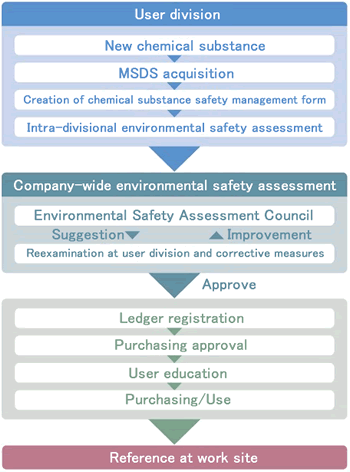Environmental Report 2010
Chemical Substance Management/PRTR Information
To manage the risks associated with chemical substances, JAE makes suitable appointments of legally designated managers and qualified personnel with consideration given to their division and age. In FY 2009, reducing chemical substances was taken up as topic in the environmental management plan and an effort was made to promote a lessening of environmental impacts caused by them.Chemical Substance Management
The introduction of a new chemical substance or piece of equipment, construction work, increased waste volume, and other changes require an environmental safety assessment under JAE's in-house pre-assessment system. For chemical substances, it has prepared an ad hoc chemical substance safety management form for the entry of requisite information on items including transport, storage, handling, and disposal. New chemical substances in particular can only be purchased if they pass this assessment. The pre-assessment flow for new chemical substances is shown below.The following table presents data for chemical substance registration in FY 2009. JAE inspects and registers many chemicals for R&D and process improvement. In conjunction with this, it also reviews the use of many chemicals that are no longer needed, but with the total number in recent years, the company has been aggressively trying to implement further cuts in the number that are no longer needed.
■JAE Akishima Plant
| 2007 | 2008 | 2009 | |
|---|---|---|---|
| Number registered | 2,093 | 2,217 | 2,249 |
| Discontinued | 128 | 48 | 52 |
| New | 172 | 172 | 84 |
| Number of distinct chemical substances registered | 1,664 | 1,733 | 1,753 |
■Pre-assessment flowchart for new chemical substances

Reduction of Chemical Substances
In FY 2009, target substances were selected per production site to reduce environmental impacts. The goal is to reduce chemical substance use 10%. The main examples of activities for reducing chemical substances in FY 2009 are as follows.- Reduction of amount of solvents used by changing cleaning methods (SAE)
In FY 2008, studies were conducted for reducing chemical substance that were used often, excluding those for which process conditions could not be changed due to the need to ensure product performance, and reduction measures were implemented for the solvent that was number one in purchase expense and number two in the amount used.
As a result of these activities, an approximate 140 kg reduction was achieved in FY 2009 for the solvent in question, equivalent to 18% of the amount previously used. Moving forward, the feasibility of similar changes will be studied for other part cleaning, and efforts will be made to reduce VOC (volatile organic chemical) usage.
PRTR Data
The table below shows the change in the volume of PRTR-designated chemical substances used. The table's values are totals for five domestic manufacturing companies, and the number of stars (★) corresponds to the number of production sites subject to PRTR reporting. In compliance with the RoHS directive, JAE has been reducing hexavalent chromium and lead-containing chemical substances year after year, but the FY 2006 situation has stabilized to a certain degree. Usage outside RoHS targets is decided by customer demand, and the increase of lead in FY 2007 and FY 2008 was a direct result of that.Antimony trioxide may be included in the molding material for connectors due to its flame retardant properties, and starting in FY 2009, antimony and its compounds are being reduced. This is due to a change in resins that contain antimony trioxide.
Since reducing waste is also crucial in dealing with PRTR-targeted chemical substances, JAE is responding by promoting recycling, but as shown in the table, the company recognizes there are few PRTR-designated chemical substances and the amount used is not that high. JAE is also making active use of electronic reporting.
■Change in Volume of PRTR-Designated Chemical Substances Used Unit:tons
| Fiscal | 2006 | 2007 | 2008 | 2009 |
|---|---|---|---|---|
| Antimony and its compounds | ★★3.5 | ★★11.2 | ★★19.9 | ★★4.9 |
| Inorganic cyanide compounds | ★2.6 | ★2.7 | ★2.1 | ★1.8 |
| Hexavalent chromium compounds | 0.17 | 0.16 | 0.14 | 0.15 |
| Nickel | ★6.8 | ★7.7 | ★5.8 | ★6.0 |
| Nickel compounds | ★★2.8 | ★2.7 | ★1.9 | ★2.5 |
| Hydrogen fluoride and its water-soluble salts | ★★4.2 | ★★5.2 | ★★4.6 | ★3.4 |
| Lead and its compounds | 0.11 | 0.21 | 0.30 | 0.10 |